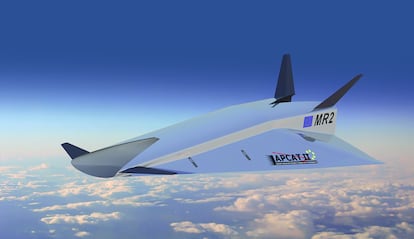Will we be able to fly from Paris to New York in less than an hour without contributing to global warming?
While flying is a major contributor to the climate crisis, behind the scenes scientists are designing cleaner and faster airliners

Traditionally designed for efficiency and safety, passenger planes are now increasingly being developed with climate neutrality in mind as well.
So the question arises: will people one day be able to count on flying from Paris to New York in less than an hour without contributing to global warming?
Sky-high ambitions
That’s what the EU-funded STRATOFLY project proposed: a Mach 8 airliner — a hypersonic aircraft that can go at least 9,500 kilometers (5,900 miles) per hour, or about eight times the speed of sound. STRATOFLY, which ran from 2018 to 2021, built on three previous EU research projects in the field.
“It’s going be a real challenge,” said Nicole Viola, who coordinated STRATOFLY and is a professor at the Polytechnic University of Turin in Italy. “Maybe we’re not ready yet for Mach 8 right now. But I’m sure that I will see a hypersonic airliner in my lifetime.”
STRATOFLY designed a prototype in the form of a computer model for a hydrogen-fuelled hypersonic plane. The project focused on innovative ways of powering an aircraft able to carry 300 passengers.
In the meantime, the political appetite in the EU for supersonic passenger air travel has waned in large part because of environmental concerns, not least noise and emissions of pollutants that cause climate change.
Recent EU regulatory initiatives, including a new law to cut aviation emissions, have highlighted the political skepticism in Europe by limiting incentives for supersonic commercial flights.
Still, in the worlds of civil aviation and research, ambitious ideas persist to make faster and cleaner airplanes. While these technologies might take many decades to enter service, it’s important to dream big now, according to scientists.
The EU is funding numerous research initiatives covering a range of fundamental technologies, including hydrogen-related ones, to make aviation safe, efficient and clean. The goals are aligned with national, international and business priorities.
Not so fast
The STRATOFLY design came with plenty of technological challenges. But one of the biggest sticking points wasn’t so much to create an aircraft that could fly fast, but rather to design one that could also fly slowly.
“The challenge isn’t in the hypersonic phase,” said Viola.
The hypersonic airliner that she and her colleagues dreamed up would need not only to fly at high speeds, but also to take off and land at much lower velocities.
This produces design challenges. An engine capable of hypersonic speeds, for example, isn’t the best option for lower speeds. A hypersonic engine also needs a huge inlet to “breathe in” air, which gets mixed with hydrogen.
“As the speed grows, the inlet grows as well,” said Viola.
But at a lower speed, less air needs to get sucked into the engine. This requires scientists to make a compromise in the design.
The 94-meter aircraft contains a massive inlet in the nose, with sliding doors to regulate the air intake. From take-off to a speed of around 5,000 kilometers (3,100 miles) per hour, six smaller engines do all the work. Above that velocity, one massive engine extending along the tail thrusts the aircraft forward. Beyond questions of pure design, STRATOFLY demonstrated the advantages of exploiting liquid hydrogen instead of hydrocarbon as an aircraft fuel.
Back to the future
The STRATOFLY proposal is only a concept designed to demonstrate what a hypersonic airliner could look like. It allows researchers to test and think about new technologies that might take decades to build successfully.
Today, however, the aviation industry might be returning to supersonic airliners like the famed Concorde, which was in service for more than 30 years before being retired in 2003. Used by Air France and British Airways, the Concorde was best known for its Paris-New York and London-New York routes, featuring one-way travel times of three to three-and-a-half hours.
Boom Aerospace, a U.S. company, has already signed contracts on supersonic design with United Airlines and American Airlines.
And hypersonic flight is attracting attention beyond civil aviation. The space industry is eyeing the technology to build craft that can take off like a plane, a development that could reduce the need for expensive rocket launches.
“Hypersonic is somewhere between aviation and space,” said Viola. “So, eventually, we will see one of those fields take up the technology.”
Clearing the air
Regardless of whether such high-speed flying eventually becomes possible, making aviation fuels cleaner is a growing EU priority. Today, aviation accounts for around 2.5% of global CO2 emissions.
Hydrogen might be the solution here, according to Professor Bobby Sethi of Cranfield University in the U.K.
“We have been researching hydrogen for aviation for a long time,” Sethi said. “The costs, however, have long dampened enthusiasm. But its introduction is a question of when, not if.”
He coordinated the EU-funded project ENABLEH2, which examined the potential of hydrogen in aviation over four years, through last November.
There is much to like about hydrogen, according to Sethi.
It is one of the most abundant elements on Earth and, if generated with renewable energy, emits no CO2. In addition, the ENABLEH2 research showed that hydrogen combustion systems will deliver lower emissions of NOx, another greenhouse gas, than kerosene.
Furthermore, aircraft powered by hydrogen can fly longer distances than electrified planes, which will likely be used only for short to medium-range flights.
Transition routes
But then there are the costs. Hydrogen behaves differently than regular aviation fuel, so planes and some airports would need to be completely redesigned — a transition that could take around 20 to 30 years, according to Sethi.
“We could technically redesign an existing aircraft, like an Airbus A380, to use hydrogen,” he said. “But you would need to install hydrogen tanks in the aircraft. We can"t just store the fuel in the wings as is done now, which makes the model uncompetitive with regular fuel or sustainable aviation fuels.”
That’s why most predictions foresee an intermediate period when the industry uses alternative sustainable aviation fuels (SAF), which are generally made from sources such as biomass or waste and produce less life-cycle CO2 compared with regular jet fuel.
According to Sethi, it would be better to "focus on carbon capture of aviation emissions in the intermediate period and invest aggressively in hydrogen to reduce the transition time."
Regardless of the path taken, the key for Sethi is a long-term and sustainable future for the industry.
“Aviation has enormous social and economic benefits,” he said. “It has lowered transport times across the globe drastically and has been a driver of economic growth through, for example, tourism. We can’t let that be destroyed.”
(This article was updated on May 10, 2023 to add EU political context and to mention the existence of an array of European projects in the field.)
Research in this article was funded by the EU. This article was originally published in Horizon, the EU Research and Innovation magazine
Tu suscripción se está usando en otro dispositivo
¿Quieres añadir otro usuario a tu suscripción?
Si continúas leyendo en este dispositivo, no se podrá leer en el otro.
FlechaTu suscripción se está usando en otro dispositivo y solo puedes acceder a EL PAÍS desde un dispositivo a la vez.
Si quieres compartir tu cuenta, cambia tu suscripción a la modalidad Premium, así podrás añadir otro usuario. Cada uno accederá con su propia cuenta de email, lo que os permitirá personalizar vuestra experiencia en EL PAÍS.
¿Tienes una suscripción de empresa? Accede aquí para contratar más cuentas.
En el caso de no saber quién está usando tu cuenta, te recomendamos cambiar tu contraseña aquí.
Si decides continuar compartiendo tu cuenta, este mensaje se mostrará en tu dispositivo y en el de la otra persona que está usando tu cuenta de forma indefinida, afectando a tu experiencia de lectura. Puedes consultar aquí los términos y condiciones de la suscripción digital.
More information
Últimas noticias
‘Fallout’ or how the world’s largest company turned an anti-capitalist apocalyptic Western into a phenomenon
From inflation to defending migrants: Eileen Higgins and Zohran Mamdani inaugurate the new Democratic resistance against Trump
EU’s prestige at stake with proposal to fund Ukrainian war effort with Russian assets
Mustafa Suleyman: ‘Controlling AI is the challenge of our time’
Most viewed
- ‘El Limones’ and the growing union disguise of Mexican organized crime
- Christian Louboutin: ‘Young people don’t want to be like their parents. And if their parents wear sneakers, they’re going to look for something else’
- ‘We are dying’: Cuba sinks into a health crisis amid medicine shortages and misdiagnosis
- The low-cost creative revolution: How technology is making art accessible to everyone
- A mountaineer, accused of manslaughter for the death of his partner during a climb: He silenced his phone and refused a helicopter rescue










































